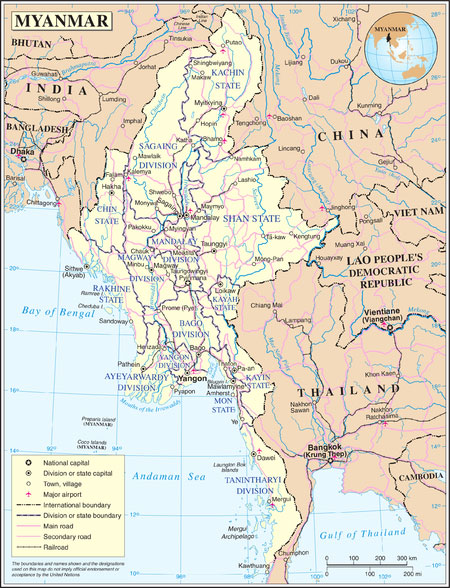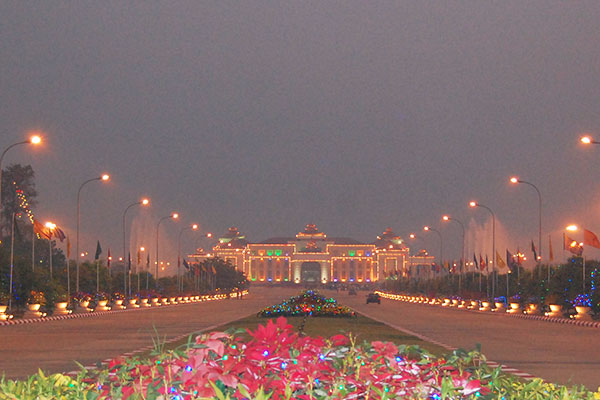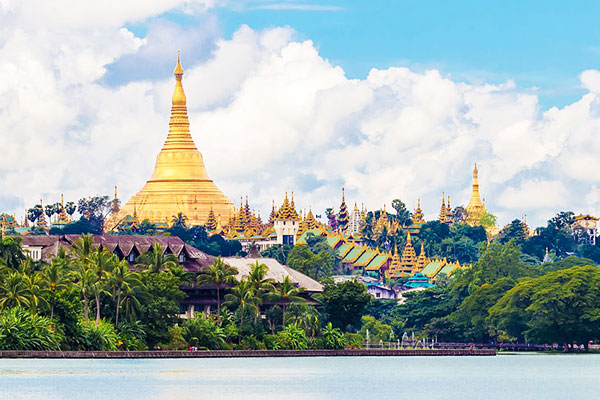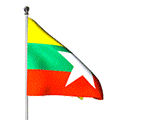Introduction to Myanmar
MYANMAR is a new and emerging tourist destination in South East Asia. Known to most travelers as the Golden land, Myanmar is rich in cultures and natural attractions. There are numerous pagodas, temples, beauty spots, archaeological sites, snow-peaked mountains, deep forests with abundant flora and fauna, rivers and natural lakes, unspoilt beaches and archipelagos, 135 national races with their colourful costumes and customs, traditional arts and crafts all make up Myanmar the most exotic and fascinating destination in Asia. Visitors will find Myanmar a beautiful and peaceful place with the most hospitable people in the world.
LOCATION
 Myanmar is situated in Southeast Asia and is bordered on the north and northeast by China, on the east and southeast by Laos and Thailand, on the south by the Andaman Sea and the Bay of Bengal and on the west by Bangladesh and India. It is located between latitudes 09º 32′ N and 28º 31′ N and longitudes 92º 10′ E and 101º 11′ E.
Myanmar is situated in Southeast Asia and is bordered on the north and northeast by China, on the east and southeast by Laos and Thailand, on the south by the Andaman Sea and the Bay of Bengal and on the west by Bangladesh and India. It is located between latitudes 09º 32′ N and 28º 31′ N and longitudes 92º 10′ E and 101º 11′ E.
GEOGRAPHY
The country covers an area of 677,000 square kilometres (261,228 square miles) ranging 936 kilometres (581 miles) from east to west and 2,051 kilometres (1,275 miles) from north to south, It is a land of hills and valleys and is rimmed in the north, east and west by mountain ranges forming a giant horseshoe. Enclosed within the mountain barriers are the flat lands of Ayeyarwaddy, Chindwin and Sittaung River valleys where most of the country’s agricultural land and population are concentrated.
CLIMATE
As a whole, the location and topography of the country generated a diversity of climate conditions. Seasonal changes in the monsoon wind directions create summer, rainy and winter seasons. Extremes of temperature are rare. The directions of winds and depression bring rain, and although it is always heavy in the coastal areas during monsoon season, it seldom creates hardships. The Government is giving priority to the forest conservation and greening of nine arid districts in central Myanmar.
FLORA AND FAUNA
Myanmar is endowed with a rich diversity of habitat types arising largely from its unusual ecological diversity. It is home to nearly 300 known mammal species, 300 reptiles and about 100 birds species, and a haven for about 7,000 species of plant life. Since Myanmar considers such a rich pool of bio diversity as an important national asset, the Government has drawn up strict regulations to protect its biological resources.
POPULATION
Myanmar is made up of 135 national races, of which the main national races are Kachin, Kayah, Kayin, Chin, Bamar, Mon, Rakhine and Shan. Population of the country is estimated at 52.4 million (July, 2003) and the population growth rate is 1.84 percent.
 Nay Pyi Taw
Nay Pyi Taw Yangon
Yangon Mandalay
Mandalay Bagan
BaganTOURISM
Myanmar possesses a rich and vibrant cultural tradition. Great natural beauty combines with magnificent temple architecture. Traditionally, Myanmar tourism is based on culture. Myanmar with its long history, culture and religion has many pagodas, temples and monuments all over the country. In addition, Myanmar is also blessed by nature with natural attractions. There are snow-capped mountains, deep forests, cool and scenic places, long rivers, beautiful lakes, and manu unspoiled beaches and archipelagoes. The different national races and their way of life, traditional arts and crafts offer exotic vistas of the nation while the warm hospitality of Myanmar people world-renowned.
HISTORICAL BACKGROUND
Myanmar has a long history and its greatness dates back to the early 11th Century when King Anawrahta unified the country and founded the First Myanmar Empire in Bagan more than 20 years before the Norman Conquest of England in 1066. The Bagan Empire encompassed the areas of the present day Myanmar and the entire Menam Valley in Thailand and lasted two centuries. The Second Myanmar Empire was founded in 16th Century by King Bayinnaung styled Branginoco by the Portuguese. King Alaungpaya founded the last Myanmar Dynasty in 1752 and it was during the zenith of this Empire that the British moved into Myanmar Wars in 1825. During The Second World War, Myanmar was occupied by the Japanese from 1942 till the return of the Allied Forces in 1945. Myanmar becomes a sovereign independent state in January 1948 after more than 100 years of colonial administration.



